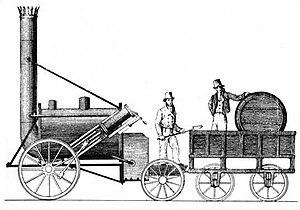Rocket (locomotive)
| Rocket | |||||||||||||||||||||||||||
|---|---|---|---|---|---|---|---|---|---|---|---|---|---|---|---|---|---|---|---|---|---|---|---|---|---|---|---|

A contemporary drawing of Rocket
|
|||||||||||||||||||||||||||
|
|||||||||||||||||||||||||||
|
|||||||||||||||||||||||||||
|
|||||||||||||||||||||||||||
|
|||||||||||||||||||||||||||
| Type and origin | |
|---|---|
| Power type | Steam |
| Builder | Robert Stephenson and Company |
| Build date | 1829 |
| Specifications | |
|---|---|
| Configuration: |
|
| • Whyte | 0-2-2 |
| • UIC | A1 n2 |
| Gauge | 4 ft 8 1⁄2 in (1,435 mm) standard gauge |
| Driver dia. | 4 ft 8 1⁄2 in (1.44 m) |
| Trailing dia. | 2 ft 6 in (0.76 m) |
| Axle load | 2 long tons 12 cwt 1 qr (5,850 lb or 2.65 t) |
| Loco weight | 4 long tons 5 cwt (9,500 lb or 4.3 t) |
| Fuel type | Coke |
| Boiler pressure | 50 lbf/in2 (340 kPa) |
| Cylinders | Two, outside |
| Cylinder size | 8 in × 17 in (203 mm × 432 mm) |
| Performance figures | |
|---|---|
| Maximum speed | 28 mph (45 km/h) |
| Career | |
|---|---|
| Operators |
Liverpool and Manchester Railway Lord Carlisle's Railway |
| Current owner | Science Museum |
Stephenson's Rocket was an early steam locomotive of 0-2-2 wheel arrangement. It was built for, and won, the Rainhill Trials held by the Liverpool & Manchester Railway in 1829 to choose the best design to power the railway.
Rocket was designed by Robert Stephenson in 1829, and built at the Forth Street Works of his company in Newcastle upon Tyne.
Though the Rocket was not the first steam locomotive, it was the first to bring together several innovations to produce the most advanced locomotive of its day. It is the most famous example of an evolving design of locomotives by Stephenson that became the template for most steam engines in the following 150 years.
The locomotive was preserved and is now on display in the Science Museum in London.
The locomotive had a tall smokestack chimney at the front, a cylindrical boiler in the middle, and a separate firebox at the rear. The large front pair of wooden wheels was driven by two external cylinders set at an angle. The smaller rear wheels were not coupled to the driving wheels, giving an 0-2-2 wheel arrangement.
Stephenson designed Rocket for the Rainhill trials, and the specific rules of that contest. As the first railway intended for passengers more than freight, the rules emphasised speed and would require reliability, but the weight of the locomotive was also tightly restricted. Six-wheeled locomotives were limited to six tons, four-wheeled locomotives to four and a half tons. In particular, the weight of the train expected to be hauled was to be no more than three times the actual weight of the locomotive. Stephenson realised that whatever the size of previously successful locomotives, this new contest would favour a fast, light locomotive of only moderate hauling power.
Stephenson's most visible decision was to use a single pair of driving wheels, with a small carrying axle behind. This was the first 0-2-2 and first single driver locomotive. The use of single drivers gave several advantages. The weight of coupling rods was avoided and the second axle could be smaller and lightweight, as it only carried a small proportion of the weight. Rocket placed just over 2½ tons of its 4¼ ton total weight onto its driving wheels, a higher axle load than Sans Pareil, even though the 0-4-0 was heavier overall at 5 ton, and officially disqualified by being over the 4½ ton limit. Early locomotive designers had been concerned that the adhesion of a locomotive's driving wheels would be inadequate, but Stephenson's past experience convinced him that this would not be a problem, particularly with the light trains of the trials contest.
...
Wikipedia
